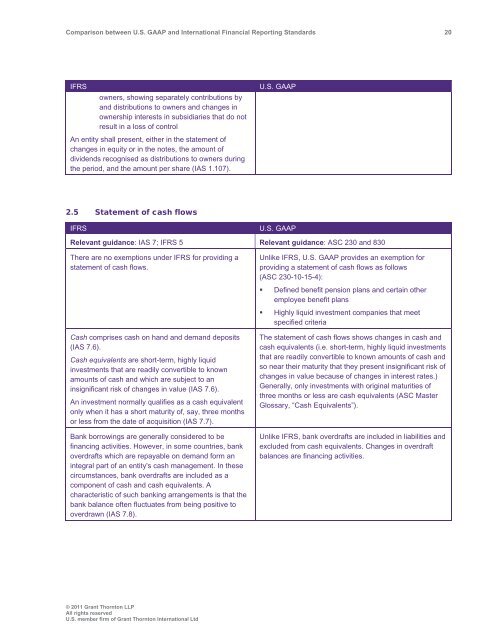Comparison between U.S. GAAP and International ... - Grant Thornton
Comparison between U.S. GAAP and International ... - Grant Thornton
Comparison between U.S. GAAP and International ... - Grant Thornton
Create successful ePaper yourself
Turn your PDF publications into a flip-book with our unique Google optimized e-Paper software.
<strong>Comparison</strong> <strong>between</strong> U.S. <strong>GAAP</strong> <strong>and</strong> <strong>International</strong> Financial Reporting St<strong>and</strong>ards 20<br />
IFRS<br />
owners, showing separately contributions by<br />
<strong>and</strong> distributions to owners <strong>and</strong> changes in<br />
ownership interests in subsidiaries that do not<br />
result in a loss of control<br />
An entity shall present, either in the statement of<br />
changes in equity or in the notes, the amount of<br />
dividends recognised as distributions to owners during<br />
the period, <strong>and</strong> the amount per share (IAS 1.107).<br />
U.S. <strong>GAAP</strong><br />
2.5 Statement of cash flows<br />
IFRS<br />
U.S. <strong>GAAP</strong><br />
Relevant guidance: IAS 7; IFRS 5 Relevant guidance: ASC 230 <strong>and</strong> 830<br />
There are no exemptions under IFRS for providing a<br />
statement of cash flows.<br />
Cash comprises cash on h<strong>and</strong> <strong>and</strong> dem<strong>and</strong> deposits<br />
(IAS 7.6).<br />
Cash equivalents are short-term, highly liquid<br />
investments that are readily convertible to known<br />
amounts of cash <strong>and</strong> which are subject to an<br />
insignificant risk of changes in value (IAS 7.6).<br />
An investment normally qualifies as a cash equivalent<br />
only when it has a short maturity of, say, three months<br />
or less from the date of acquisition (IAS 7.7).<br />
Bank borrowings are generally considered to be<br />
financing activities. However, in some countries, bank<br />
overdrafts which are repayable on dem<strong>and</strong> form an<br />
integral part of an entity's cash management. In these<br />
circumstances, bank overdrafts are included as a<br />
component of cash <strong>and</strong> cash equivalents. A<br />
characteristic of such banking arrangements is that the<br />
bank balance often fluctuates from being positive to<br />
overdrawn (IAS 7.8).<br />
Unlike IFRS, U.S. <strong>GAAP</strong> provides an exemption for<br />
providing a statement of cash flows as follows<br />
(ASC 230-10-15-4):<br />
• Defined benefit pension plans <strong>and</strong> certain other<br />
employee benefit plans<br />
• Highly liquid investment companies that meet<br />
specified criteria<br />
The statement of cash flows shows changes in cash <strong>and</strong><br />
cash equivalents (i.e. short-term, highly liquid investments<br />
that are readily convertible to known amounts of cash <strong>and</strong><br />
so near their maturity that they present insignificant risk of<br />
changes in value because of changes in interest rates.)<br />
Generally, only investments with original maturities of<br />
three months or less are cash equivalents (ASC Master<br />
Glossary, “Cash Equivalents”).<br />
Unlike IFRS, bank overdrafts are included in liabilities <strong>and</strong><br />
excluded from cash equivalents. Changes in overdraft<br />
balances are financing activities.<br />
© 2011 <strong>Grant</strong> <strong>Thornton</strong> LLP<br />
All rights reserved<br />
U.S. member firm of <strong>Grant</strong> <strong>Thornton</strong> <strong>International</strong> Ltd
















